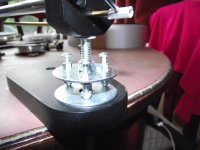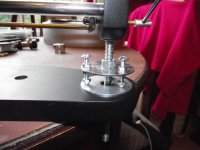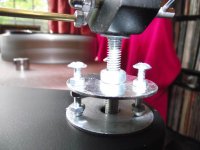Colin, et alii ... no offence girls. My bearings are instrument quality (grade 3 or 4) and a super smooth rod should not be necessary, but ...! Sorry Squirrel, don't mean to step on your toes.
Having trouble realizing the right direction to go.
Any help appreciated.
Zene
Why not test both and give us your verdict? The problem with tungsten carbide is that it would be very hard to polish it yourself.
I have polished my own telescope mirrors made of glas and are aquinted with the work involved. Still thinking on how to polish a rod to perfection... Gravity is your friend making a sperical mirror -3D, how do we grind and polish a circular rod -2D? This might be totally unneccesary of course but there is always the IF - if we could - would it be worthwhile?
Brgds
Having trouble realizing the right direction to go.
Any help appreciated.
Zene
Simple Solution. Use the K.I.S.S. principle first. (Keep It Simple Sam). Then upgrade the parts as u see fit and compare.
A properly done flame polish uses the nature of surface tension to achieve a superior surface, particularly on an amorphous material.
Simple Solution. Use the K.I.S.S. principle first. (Keep It Simple Sam). Then upgrade the parts as u see fit and compare.
A properly done flame polish uses the nature of surface tension to achieve a superior surface, particularly on an amorphous material.
Yes Scott - this will take care of microscopic roughness but probably worsen things at the macroscale...
If the macroscale isn't right there will be fluctuations in azimuth.
Oh yes, this one is for them who looks at other materials than glass. Taken a new tube from shelf and using it. What implications would it do to azimuth given it looks straight, no imperfections that your eye can see? What amount of error would this end in if we count degrees? Remember that we see in wavelenghts - nothing our regular workshop tools allow us to measure so rather trust your eyes than your tools in this regard. Would we be able to hear this imperfection - of course not! But then again it is up to us as individuals to seek perfection. Take the road you believe in and report both the bad and the good parts of your findings.
Brgds
Last edited:
I'm up and running with the 12mm glass tubes. It does work well and I acknowledge the views that it is the most cost effective solution. I need to pay more attention to the bearings. They are SKF (Japan) but I can see without magnification that they are not perfect.
Would a dremel buff and chrome polish suffice?
I also need to change the wire as the mouse wire has kinked and twisted and now needs extra care in dressing. I have transfi wire on order.
I am now using a >20 year old AT F5 (boron cantilever) which sounded awful when used with my Michell Synchro in those days. It now sounds great and has lifted me out of my slightly jaded vinyl hobby.
Still planning more changes. a) A movable mount to adjust offset rather than moving in the headshell. b) Better wire c) get the motor a bit quieter.....
I strongly suggest getting it working with what you have and making improvements later. Exotic materials are not necessary. MDF works fine and will give you a better idea of what suits your setup. It doesn't take much and the rewards are considerable. I plan to sell a couple of my older arms now.
I have plenty of spare 12mm x 200mm tubes if anyone wants some.
kffern
Would a dremel buff and chrome polish suffice?
I also need to change the wire as the mouse wire has kinked and twisted and now needs extra care in dressing. I have transfi wire on order.
I am now using a >20 year old AT F5 (boron cantilever) which sounded awful when used with my Michell Synchro in those days. It now sounds great and has lifted me out of my slightly jaded vinyl hobby.
Still planning more changes. a) A movable mount to adjust offset rather than moving in the headshell. b) Better wire c) get the motor a bit quieter.....
I strongly suggest getting it working with what you have and making improvements later. Exotic materials are not necessary. MDF works fine and will give you a better idea of what suits your setup. It doesn't take much and the rewards are considerable. I plan to sell a couple of my older arms now.
I have plenty of spare 12mm x 200mm tubes if anyone wants some.
kffern
I'm up and running with the 12mm glass tubes. It does work well and I acknowledge the views that it is the most cost effective solution. I need to pay more attention to the bearings. They are SKF (Japan) but I can see without magnification that they are not perfect.
Would a dremel buff and chrome polish suffice?
I also need to change the wire as the mouse wire has kinked and twisted and now needs extra care in dressing. I have transfi wire on order.
I am now using a >20 year old AT F5 (boron cantilever) which sounded awful when used with my Michell Synchro in those days. It now sounds great and has lifted me out of my slightly jaded vinyl hobby.
Still planning more changes. a) A movable mount to adjust offset rather than moving in the headshell. b) Better wire c) get the motor a bit quieter.....
I strongly suggest getting it working with what you have and making improvements later. Exotic materials are not necessary. MDF works fine and will give you a better idea of what suits your setup. It doesn't take much and the rewards are considerable. I plan to sell a couple of my older arms now.
I have plenty of spare 12mm x 200mm tubes if anyone wants some.
kffern
I will have 2 10mm for sale in southern Sweden by soon just to take care of the gas bill
Brgds
Turbon:
I am glad to see you know about precision tolerances ( mirror grinding is an art ).
If you buy a ground and polished tungsten carbide blank it will be more than adequate as is. However you can polish it further using some diamond lapping compound in various grades available on ebay for a couple of dollars. The main idea of using tungsten carbide is for its guaranteed dimensional accuracy.
Vynuhl.addict:
Your capacitor comparison is a good one.
I am not debating the use of tungsten carbide vs glass. You are missing my point. So long as the glass/ceramic tubing is ground and polished by the factory it will be perfectly suitable. Using any extruded material for a precision instrument such as this arm is a crap shoot IMHO even though it may work well. A conventional tonearm with some out of spec bearing would still work---but will not sound its best.
Tolerances of mechanical parts is always relative to the task at hand. For example--A .001 inch error in a telescope mirror would be a disaster ( poor image quality) yet you will still have an image.
Now we are expecting a cartridge to "perfectly" track a record groove that is .002 inch-.003 inch wide at a fairly high velocity without any problems in a carriage with precise bearing riding on glass tube of unknown quality. Not be best way to get top performance IMHO.
Its all about dimensional accuracy of the carriage support ( and bearing quality ). Any imperfections in the carriage support, carriage alignment, bearing surface etc. will be transmitted directly to the cartridges' suspension and cause problems--may be major or minor depending on the amount of total error in the arm.
My comments here are not to discourage anyone from making this arm, but if you want to get the best performance you must use the best parts possible. The price between " good parts" and "excellent parts" is not much money.
Joe
I am glad to see you know about precision tolerances ( mirror grinding is an art ).
If you buy a ground and polished tungsten carbide blank it will be more than adequate as is. However you can polish it further using some diamond lapping compound in various grades available on ebay for a couple of dollars. The main idea of using tungsten carbide is for its guaranteed dimensional accuracy.
Vynuhl.addict:
Your capacitor comparison is a good one.
I am not debating the use of tungsten carbide vs glass. You are missing my point. So long as the glass/ceramic tubing is ground and polished by the factory it will be perfectly suitable. Using any extruded material for a precision instrument such as this arm is a crap shoot IMHO even though it may work well. A conventional tonearm with some out of spec bearing would still work---but will not sound its best.
Tolerances of mechanical parts is always relative to the task at hand. For example--A .001 inch error in a telescope mirror would be a disaster ( poor image quality) yet you will still have an image.
Now we are expecting a cartridge to "perfectly" track a record groove that is .002 inch-.003 inch wide at a fairly high velocity without any problems in a carriage with precise bearing riding on glass tube of unknown quality. Not be best way to get top performance IMHO.
Its all about dimensional accuracy of the carriage support ( and bearing quality ). Any imperfections in the carriage support, carriage alignment, bearing surface etc. will be transmitted directly to the cartridges' suspension and cause problems--may be major or minor depending on the amount of total error in the arm.
My comments here are not to discourage anyone from making this arm, but if you want to get the best performance you must use the best parts possible. The price between " good parts" and "excellent parts" is not much money.
Joe
Et and al, whoever they are. I'm not contesting the rod, but an assault on ball bearings is forthcoming. Most of this is covered, but I wanted my views in here, also. Ball bearings are made to roll, not slide, again nothing new, but somewhere along the line we want them to roll laterally which takes a certain amount of friction or they wouldn't roll and still climb up and down the tube vertically and diagonally. You can't have it both ways and maintain anything uniform. If you get inside of a ball bearing (mentally of course) you might be amazed at what goes on there. They shake, rattle, roll and even the best can grind, but usually within allowable tolerance depending on the application. We are asking a bearing to go beyond any bearing's capabilities. They just aren't made. A bearing listening tester is quite easy to make if any interest.
So where is he going with the negative bearing thing? Simple, don't use them. Mine are about as good as you can get and I'm not touching them with a ten inch pole. Put them on your lift if you desire.
After considering the possibilities for anything to slide along I found nothing I would consider. It must have zero contact tolerance and almost no contact area, super low coefficient of friction in all planes, and available. We have the product encased in a steel shell. Take out the balls and throw the rest away. Not sure which bearing size or type will work best and I am leaving the committee to help decide. They are cheap, plentiful and super easy to install. Just fix 4 to a small platform, add the rest of the stuff and listen. Don't like; build another. This is the only time I like the try different stuff routine.
Nothing will slide along easier. Damping must enter the equation, too.
Zene
So where is he going with the negative bearing thing? Simple, don't use them. Mine are about as good as you can get and I'm not touching them with a ten inch pole. Put them on your lift if you desire.
After considering the possibilities for anything to slide along I found nothing I would consider. It must have zero contact tolerance and almost no contact area, super low coefficient of friction in all planes, and available. We have the product encased in a steel shell. Take out the balls and throw the rest away. Not sure which bearing size or type will work best and I am leaving the committee to help decide. They are cheap, plentiful and super easy to install. Just fix 4 to a small platform, add the rest of the stuff and listen. Don't like; build another. This is the only time I like the try different stuff routine.
Nothing will slide along easier. Damping must enter the equation, too.
Zene
Hello Zene
I'm sure you know that bearing balls may be purchased by themselves without having to destroy complete bearings? The rest of your post is somewhat vague. How do you intend to fix the balls to the "small platform"? Where do we go from there? I certainly appreciate people who think outside the proverbial box, but the box should be a little more transparent Maybe a sketch would help.
Maybe a sketch would help.
Sincerely,
Ralf
I'm sure you know that bearing balls may be purchased by themselves without having to destroy complete bearings? The rest of your post is somewhat vague. How do you intend to fix the balls to the "small platform"? Where do we go from there? I certainly appreciate people who think outside the proverbial box, but the box should be a little more transparent
Sincerely,
Ralf
Ralf ... Certainly more questions in my post than answers. That's why I placed it as most of you, especially Colin have much more experience at this. Of course one does not remove the balls. That should have been a easily understood funny. As far as mounting I would imagine almost anything would work. That's part of the game. Should they be rigidly mounted or somewhat forgiving like a Silicone mount? Nothing to sketch I just thought this up last night. Ideas should not have to drawn up and presented in finite details.
Zene
Zene
Ralf ... Certainly more questions in my post than answers. That's why I placed it as most of you, especially Colin have much more experience at this. Of course one does not remove the balls. That should have been a easily understood funny. As far as mounting I would imagine almost anything would work. That's part of the game. Should they be rigidly mounted or somewhat forgiving like a Silicone mount? Nothing to sketch I just thought this up last night. Ideas should not have to drawn up and presented in finite details.
Zene
So they are not supposed to roll - only glide?
Isn't there small linear bearings that rolls in any direction?
Brgds
Turbon ... that's my idea, to glide/slide. I do rem these. You'd think there might be miniatures?
http://www.harborfreight.com/media/...ab33525d08d6e5fb8d27136e95/i/m/image_8022.jpg
Zene
http://www.harborfreight.com/media/...ab33525d08d6e5fb8d27136e95/i/m/image_8022.jpg
Zene
I'm sure you know that bearing balls may be purchased by themselves without having to destroy complete bearings? The rest of your post is somewhat vague. How do you intend to fix the balls to the "small platform"? Where do we go from there? I certainly appreciate people who think outside the proverbial box, but the box should be a little more transparentMaybe a sketch would help.
Sincerely,
Ralf
Hi all,
This discussion is heading straight back to a suggestion that Nanook or possibly Moray James made quite some time ago and I've been going to try but never getting aroundtoit. Substitute 4 ball point pen nibs for the ball bearings and let them slide. Talk about tolerances, what kind of tolerances must be maintained in a pen nib for it even to roll the ink onto the paper. Back when I was a kid ball point pens would only roll for a brief period of time before becoming useless. Remember the Reynolds Rockett?
BillG
BillG .. do you think they could write the notes as the record plays?
Do several to spread out the load and use the springs, too?
Does anyone remember spring tension gauges? Thinking something like this could be used to compare and check the sled start-up force. Oops, at $70 guess I'll make my own, can't be that hard using a digital gram scale to calibrate. Springs shouldn't hard to find.
http://www.studioonetattoosupplies.com/images/Tools/Spring_Tension_Gage.jpg
Zene
Do several to spread out the load and use the springs, too?
Does anyone remember spring tension gauges? Thinking something like this could be used to compare and check the sled start-up force. Oops, at $70 guess I'll make my own, can't be that hard using a digital gram scale to calibrate. Springs shouldn't hard to find.
http://www.studioonetattoosupplies.com/images/Tools/Spring_Tension_Gage.jpg
Zene
- Home
- Source & Line
- Analogue Source
- DIY linear tonearm


